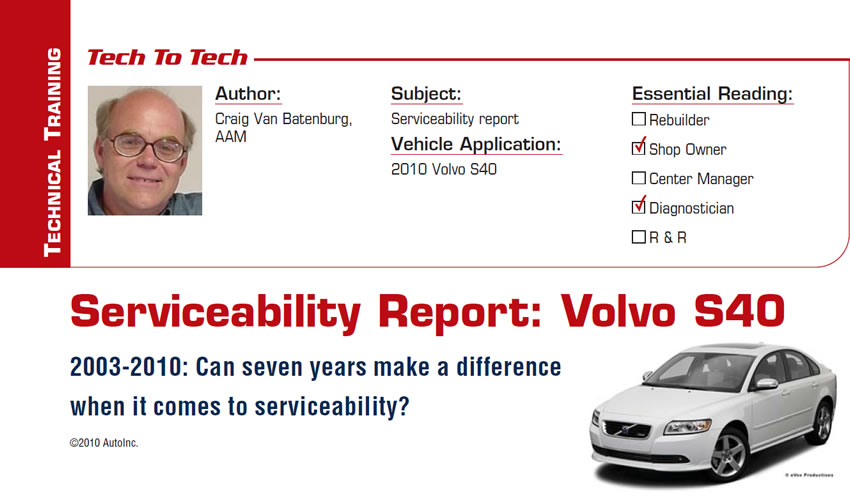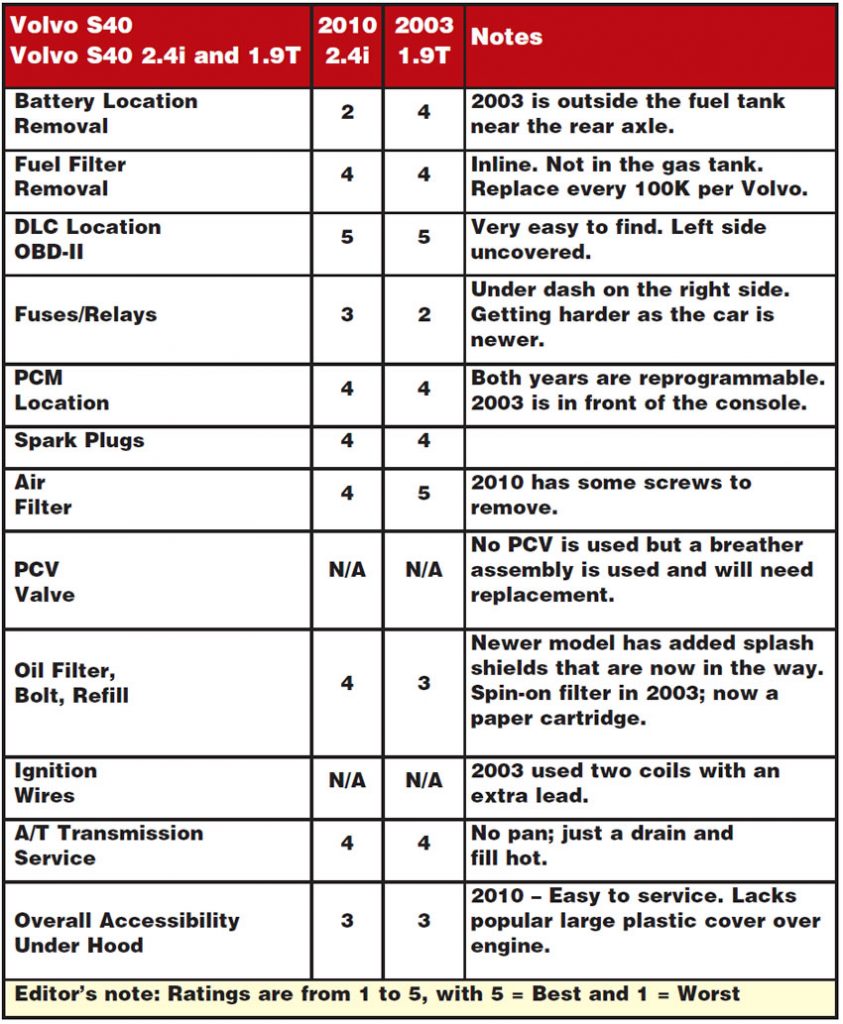
Tech to Tech
- Subject: Serviceability report
- Vehicle Application: 2010 Volvo S40
- Essential Reading: Shop Owner, Diagnostician
- Author: Craig Van Batenburg, AAM
2003-2010: Can seven years make a difference when it comes to serviceability?
Volvo. What do you think of when you hear that name? Safety? Ease of service? With that in mind, let me take you on a trip to Sweden and see what Volvo has been doing with the help of others. I have never owned a Volvo and can’t even remember working on one, but I have sure known some loyal Volvo owners – one of whom is my youngest brother, Clay. He lives in Berkeley, Calif., and is raising two teenagers, so a Volvo fits right in with his lifestyle. But is this a car that was built with a technician’s job in mind?
In the summer of 1995, the first S40 was built in a Dutch factory that originally produced the DAF (Van Doorne’s Aanhangwagen Fabriek). This was a joint venture among the Dutch government, Volvo and Mitsubishi. In 1999, Ford Motor Co. – the world’s most-profitable carmaker at that time – bought the automobile operations of Swedish-based Volvo for $6.45 billion. This is a figure slightly less than Ford’s 1998 profits of $6.57 billion. As of this writing, Volvo is for sale and may end up in the hands of the Chinese automotive company Geely – so Ford can get back to basics.
The S40 went on sale in the United States in model year 2000. In 2001, Volvo updated the S40 or 40 Series, implementing a number of technical improvements: e.g., improved engine management, direct (diesel) fuel injection, extra safety features, larger brake discs, new front suspension and steering, revised rear suspension, larger tires and a widening of the track width. Many improvements did not make it to the United States right away, although we were Volvo’s biggest customer at that time. There are two generations of the S40 in the United States – 2000 to 2004 and 2004 to 2010. An easy way to tell the difference is by the number of cylinders. The four-cylinder is a 1.9-liter, and in mid-model year 2004 the S40 came equipped with a 2.4-liter five-cylinder.

2003 S40 1.9 T
Though a full-sized, near-luxury sedan, the 2003 S40 was equipped with only a 1.9-liter four-cylinder. But with turbo power this engine was capable of producing 170 hp at 5,200 rpm and 177 lb.-ft. of torque at 1,800 rpm. This means that the engine had ample power throughout the engine’s range. It also was a segment leader at 22/32 mpg (city/hwy). The S40 was a popular Volvo, as it was the right size for city use, had a trunk and was in the mid-price range.
In March 2009, I taught a hybrid class at Arbor Motion in Ann Arbor, Mich., and met Tom. He is a well-seasoned Volvo technician and is gearing up for the Volvo hybrids heading to the United States soon. Tom helped me understand the independent side of Volvo service. Here is some of what I learned from him. Mitsubishi played a big part in the development of this car.
This is a good and durable design that is not very exciting. The turbo just keeps on spinning as long as you have changed the oil regularly and not at 7,500 miles as Volvo recommends; you must service it more frequently. If you do not take care of it, the car will not survive.
The variable valve timing on the exhaust cam works internally to provide exhaust-gas recirculation (EGR). As a result, there is little manifold vacuum, so the brake booster is often starved. An auxiliary pump provides vacuum when the engine cannot, but it may not work well in extremely cold weather – so you may have a rock-hard brake pedal.
Also, in cold weather, you may get a false code for a defective electronic traction control (ETC). If you get a car in with a new ETC, you may need to re-flash the ECU to keep the light off.
Identifix has a great four-page conversion table for standard diagnostic trouble codes to Volvo’s diagnostic trouble codes on its Web site (this is a paid site) that will help those not familiar with the Volvo system. Among common problems, the fuel-pressure regulator’s internal diaphragm ruptures and allows gasoline to leak into the fuel-pressure-regulator vacuum line.
One more issue with this year and model concerns the idle-air-control motor. When this fails or sticks, idle speed is uncontrolled and this leads to stalling.
In 2003 there were only two serious National Highway Traffic Safety Administration safety recalls – 03V424000, which fixes a weld problem on the fuel rail that allows fuel to leak; and 04V493000, a recall concerning a vacuum leak at the brake power booster.
Here are some “What were they thinking?” moments: Replacing the left headlight bulb required removing the battery and more. Replacing what serves as a positive crankcase-ventilation (PCV) system is common.

If you hear a strange hissing or rubbing noise on an older five-cylinder model, the “oil trap diaphragm” may be leaking. This will cause excessive manifold vacuum in the crankcase. This in turn causes an internal vacuum leak through the engine seals. One problem will lead to another. Replacing this part is very common. After removing the intake manifold, you will be able to remove a plastic box with baffles inside, on the side of the engine with tubes and hoses going to it. This is labor intensive, but most Volvo owners will fix it.
Volvo, like many OEMs, does not recommend flushing machines, so an automatic-transmission service is a “drain and fill” on a warmed-up car. Bleeding the cooling system can take some time, so be sure you follow the Volvo procedure when refilling the coolant.
Transmissions and engines are solid, so investments into repairs pay off in the long run. At $2,700 a year for a Web subscription for service information, not too many shops will be accessing its Web site, but other aftermarket Web sites can help you when you need specific model info. As with so many cars these days, it is important to have a technician who has some familiarity with the brand. Volvo owners are loyal and care about their cars enough to take care of them.
2010 Volvo S40 2.4i
In 2009 Volvo upped the ante in standard equipment. The base 2.4i receives features that were previously part of the select package. Among them are a power moon roof, 17-inch alloy wheels, fog lights and a 160-watt audio system with eight speakers and satellite radio. Meanwhile, the T5 in both front- and all-wheel-drive models gains the R-Design treatment with unique interior and exterior cues, a sport body kit, heated leather seats and Bluetooth. A five-speed Geartronic automatic transmission is now standard, mated to either a 168-bhp 2.4-liter five-cylinder or a 227-bhp turbocharged T5 five-cylinder engine. Optional are active HID headlights, 18-inch wheels, 650-watt 12-speaker Dynaudio sound, keyless drive, Volvo’s blind-spot warning system and an enhanced navigation system.
One feature is that the hood opens very wide, so tall technicians can stop smacking their heads. Castrol oil is recommended, and the oil cap will remind you if you forget. Oil changes are suggested by most dealerships at 3,750 miles, not the Volvo 7,500-mile interval. Make sure you use a quality oil; synthetic is best. Denso supplies the MAP sensor, so that should be trouble free. Lots of plastic under the car for cheating the wind, so charge accordingly for the extra service time. An extensive service comes due at 60K, and the timing belt should be replaced at 105K.
So what we have here is a solid car that most technicians speak highly of. Volvo may do well if it gets a new owner that adds hybrid and diesel technology, as this is a company that can make the cars our future needs. But will they?
- 2003 Ups: Loyal customers; can make money with this car.
- 2003 Downs: If you are not familiar with this vehicle, make sure you bill enough labor, as some jobs take time.
- 2010 Ups: If you service them well, it is a new revenue stream.
- 2010 Downs: More to learn; not a big seller in some parts of the country.

Craig Van Batenburg, AAM, is the owner of the Automotive Career Development Center (ACDC), www.auto-careers.org, and delivers management and technical seminars nationwide. He formerly owned Van Batenburg’s Garage Inc. in Worcester, Mass., for more than 25 years. Van Batenburg is ASE master and L1 certified, with advanced skills in hybrid drive systems. You can reach him by e-mail at [email protected]
This copyrighted article is reprinted with the permission of AutoInc., the official publication of the Automotive Service Association (ASA). To learn more about ASA and its commitment to independent automotive-service and repair professionals, visit www.ASAshop.org or call 800-272-7467.













